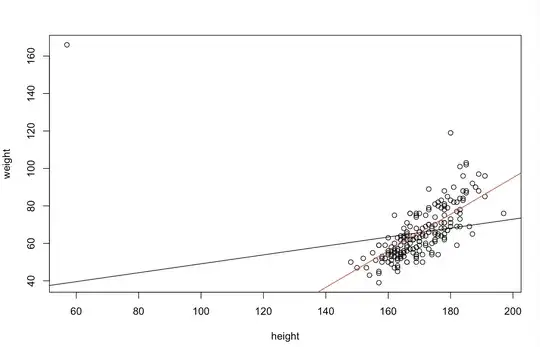I have three normally distributed random variables $m_0$, $m_1$ and $m_2$, and three fixed values $d_0$, $d_1$ and $d_2$. They represent the physical weights of objects and their placement on a solid bar of any sort. This is a balance point problem. An example is given in the following image:
(example values for additional clarity: $\mu_{m_1}=80kg$, $\sigma_{m_1}=15kg$, $d_1=100cm$)
I am interested in the nature of the resulting balance point $d$. I assume it to be normally distributed following the normally distributed "weights" $m_i$ with $d \sim N(\mu_d, \sigma_d^2)$.
Generally we know that $$d = \frac{\sum_i{m_i d_i}}{\sum_i{m_i}}$$
applies. It feels natural that the mean of $d$ is
$$\mu_d = \frac{\mu_{m_0} d_0 + \mu_{m_1} d_1 + \ ....}{\mu_{m_0} + \mu_{m_1} + \ ....},$$
however, I find myself not able to figure out the proper way to calculate the standard deviation
$$\sigma_d =\ ....$$
I checked the literature on the sum of normal distributions and the sum of weighted normal distributions. I realize that my problem is different but I can't find the right pointers.
What is the standard deviation (or variance) of the given problem statement?
Edit: Added experiment
I ran an experiment to get a feeling for the problem:
R-Script:
rtznorm <- function(n, m, s, z_limit=1.96) {
# The normal 'rnorm' function with a limitation of extremes
sample <- rnorm(n = n, mean = m, sd = s)
while(any(sample < (m - z_limit * s) | sample > (m + z_limit * s))) {
sample <- rnorm(n = n, mean = m, sd = s)
}
return(sample)
}
cg_x <- function(){
weights <- rtznorm(n=3, m=80, s=15)
x_weights <- c(0, 100, 200)
cgx = sum(weights * x_weights) / sum(weights)
return(cgx)
}
random_cgx <- replicate(500000, cg_x())
hist(random_cgx)
c(mean(random_cgx), sd(random_cgx))
A random run of the experiment resulted in $\mu= 99.981, \sigma=7.779$ and

